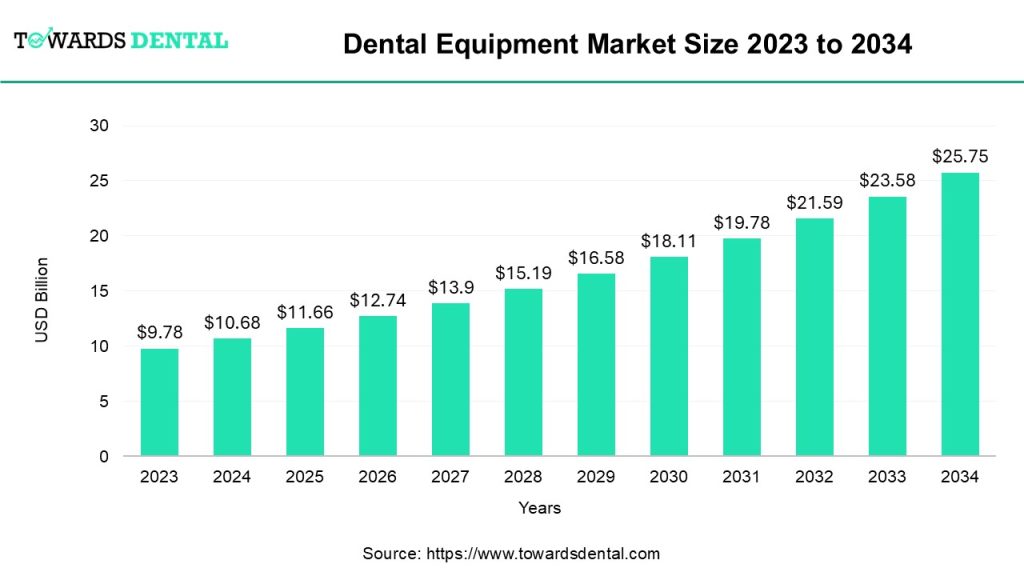DentaBot Launches Revolutionary AI-Driven Robotic Dental System to Transform Oral Care
DentaBot, a worldwide manufacturer of medical robotic systems backed by artificial intelligence, has recently unveiled an advanced AI-based surgical robot for dental operations. This advanced system revolutionized the dentist’s practice of implant placement, cavity filling, and Orthodontic adjustment. People are looking for ways to provide dental care that do not interfere with healthy oral tissues, which places DentaBot’s innovation in a very promising position.
Dental Equipment Market Size
Data from Precedence Research, the global dental equipment market size accounted for 10.68 billion in 2024 and is predicted to be worth around 25.75 billion by 2034, growing at a solid CAGR of 9.2% from 2024 to 2034.

AI-Powered DentaBot Revolutionizes Dentistry
DentaBot’s newly designed Robotic System incorporates state-of-the-art artificial intelligence algorithms that help trace and identify the patient’s oral structure in real-time. The system is intended to cut with high precision and execute other dentistry operations with little human intervention. This eliminates human errors, resulting in better operations because they are quick and less likely to result in complications.
Artificial intelligence and robotics are the trends that are felt in the dental industry at a very high pace. Based on ADA’s latest data, AI integration in dental practice skyrocketed between 2020 and 2023 by a staggering 30%. The market for dental AI technology is estimated to be USD 700 million in 2022.
DentaBot has been expanding its share for a long time and still invests a lot of money to remain an AI-based dental technology leader. YK is determined to allocate more than USD 2 billion to R&D by the year 2028 to develop efficient robotic systems. The assortment of medical devices for different dental operations, including serious surgeries. There is a need for the development of dental care solutions based on artificial intelligence resulting from increased frequency of oral diseases all over the world.
Worldwide Instances of Oral Disease
| Year | Global Population with Oral Diseases (Billion) |
| 2015 | 2.3 |
| 2020 | 3.0 |
| 2023 | 3.5 |
Governments globally are offering considerable support to speed up the use of AI solutions in healthcare systems, including oral healthcare. The FDA of the United States has authorized priority approvals when it comes to AI-driven clinical devices, and there are some incentives to propel dental practices into the 21st century. Additionally, the European Union is actively supporting the creation of health-related AI solutions through the Horizon 2020 program to make Europe a world center of AI-based medical technologies.
DentaBot’s new robotic system is powered by Artificial Intelligence, and this makes it poised for a great future in the dental industry. The adoption of AI applications is rapidly rising, and receiving support from governments and other regulatory bodies in the dental business further boosts the market. Furthermore, in the year 2027, DentaBot expects to have over 15,000 dental practices worldwide using the company’s AI systems.
Oral and Dental Health Status in the U.S. (2015-2018)
| Age Group | Percentage with Untreated Dental Caries |
| 5-19 | 13.2% |
| 20-44 | 25.9% |
| 46-64 | 25.3% |
| 65 and older | 20.2% |
With over three years of dedicated writing experience, Komal brings a unique blend of cross-domain expertise and a strong healthcare background that makes her insights not just informative but truly transformative. Komal’s passion for the healthcare sector is palpable in every piece she crafts. Her journey began with a thirst for knowledge and a desire to make a difference in the dental landscape. She understands that oral health is more than just maintaining a bright smile; it’s a vital component of overall health. This understanding fuels her commitment to delivering the latest news, trends, and innovations in dentistry to her readers.
One of Komal’s standout qualities is her ability to distill complex medical jargon into engaging, accessible content. Whether she’s unraveling the latest advancements in dental technology or exploring the implications of new policies affecting dental practices, her writing resonates with both industry professionals and everyday readers. She has a knack for turning intricate topics into captivating narratives that invite curiosity and encourage informed discussions.


